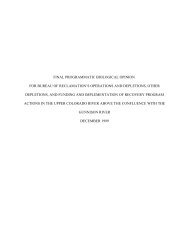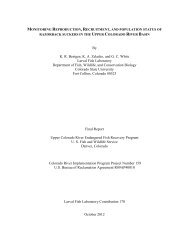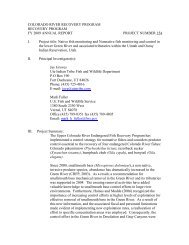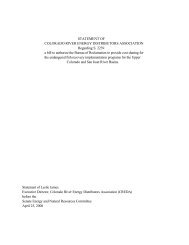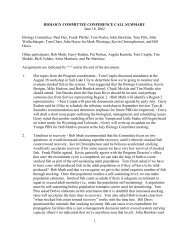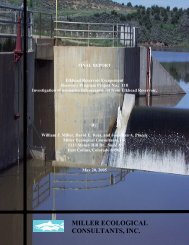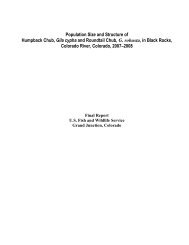riprap - Upper Colorado River Endangered Fish Recovery Program
riprap - Upper Colorado River Endangered Fish Recovery Program
riprap - Upper Colorado River Endangered Fish Recovery Program
Create successful ePaper yourself
Turn your PDF publications into a flip-book with our unique Google optimized e-Paper software.
UtahLegal protection of flows in Utah will be achieved differently than in <strong>Colorado</strong>. Severalapproaches may be taken under Utah water law to protect instream flows, including:1) acquiring existing water rights and filing change applications to provide for instreamflow purposes; 2) withdrawing unappropriated waters by governor's proclamation;3) approving presently filed and future applications subject to minimum flow levels; and4) with proper compensation, preparing and executing contracts and subordinatingdiversions associated with approved and perfected rights. Although current Utah waterlaw may not fully provide for all aspects of instream-flow protection, Utah does believethey can provide an adequate level of protection.Utah examined available flow protection approaches in the 1990’s and determined thatthe strategy they would use most commonly will be to condition the approval ofpresently filed and new applications, making them subject to predetermined streamflowlevels. To accomplish this, the State Engineer adds a condition of approval to waterrightapplications (within the area) filed after the policy is adopted. The condition statesthat whenever the flow of the Green <strong>River</strong> (or other streams) drops below thepredetermined streamflow level, then diversions associated with water rights approvedafter the condition is imposed are prohibited. Based on past legal challenges to theState's authority to impose conditions associated with new approvals, it was determinedthat this is within the authority of the State Engineer. This approach does notspecifically recognize an instream-flow right; however, it does protect the flows frombeing diverted and used by subsequently approved water rights. This approach wasadopted as policy by the State Engineer. The policy requires that presently filed andnew applications to be approved are subject to the summer and fall flowrecommendations. As flow recommendations are finalized and accepted, Utah willreview options for protecting the recommended flows. In 2009, Utah determined thatthe aforementioned “subordination” method of flow protection may not be feasible. The<strong>Recovery</strong> <strong>Program</strong>’s Water Acquisition Committee formed a task force to develop otheroptions for protecting fish flows on the Green <strong>River</strong>. This task force has joined withReclamation to conduct modeling that will incorporate hydrology and future water rightclaims to use as a planning and policy tool. In 2010, Utah identified the legal andtechnical process and schedule to protect recommended year-round flows for theendangered fishes in Utah (Utah Department of Natural Resources 2010). To date,Utah has completed their water rights model based on historical data and additionalmodel runs based on operational data are pending from Reclamation.2.2 II. RESTORE AND PROTECT HABITATImportant elements of habitat protection include restoring and managing in-channelhabitat and historically flooded bottomland areas, restoring passage to historicallyoccupied river reaches, preventing fish entrainment at diversion structures (ifwarranted), enhancing water temperatures, and reducing or eliminating the impacts ofcontaminants.7



